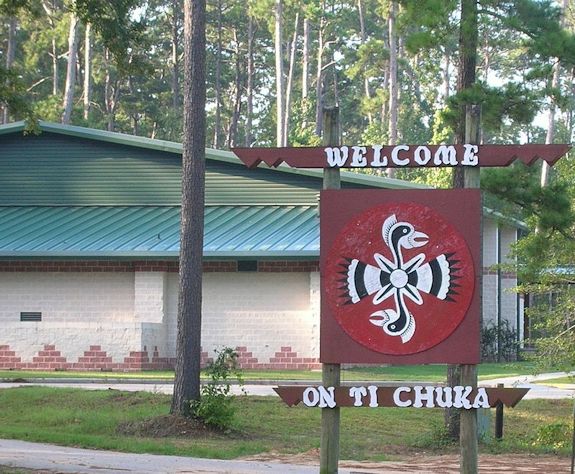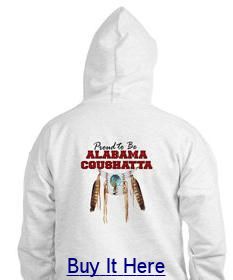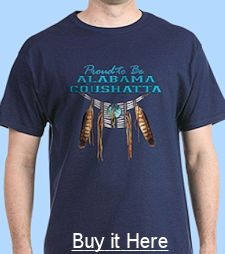Home :: US Tribes A to Z :: US Tribes A-B :: Alabama-Coushatta Tribe of Texas
Who are the Alabama-Coushatta Tribe?
The Alabama and Coushatta formed an inter-tribal friendship shortly after each tribe migrated into Texas. In the early 1800s, their original homelands were taken over by white settlers. Sam Houston recommended that the state purchase 1,280 acres for the Alabamas and set aside 640 acres for the Coushattas. The land for the Coushattas never materialized, so either through marriage or special permission, the Coushatta came to live on the allotted lands of the Alabamas – uniting the two to become the Alabama-Coushatta.

Alabama-Coushatta Tribe of Texas entrance sign By ishwar via Wikamedia Commons
Official Tribal Name: Alabama-Coushatta Tribe of Texas
Address: 571 State Park Rd 56, Livingston, TX 77351
Phone: (936) 563-1100
Email: information@actribe.org
Official Website:http://www.alabama-coushatta.com
Recognition Status: Federally Recognized
Traditional Name / Traditional Meaning:
Alibamu – Means “cleared thicket” or “vegetation gatherers”
Koasati – Means “white cane”
Common Name: Alabama-Coushatta
Meaning of Common Name: Alabama – Means “cleared thicket” Coushatta – Means “white cane”
Alternate names: Albaamaha, formerly Alabama-Coushatta Tribes of Texas
Region: Southeast Region
State(s) Today: Texas
Traditional Territory:
 The Alabamas were once part of the Moundville chiefdom located in western Alabama and eastern Mississippi, and the Coushattas were connected with the Coste chiefdom, located near Bussell Island in present-day eastern Tennessee.
The Alabamas were once part of the Moundville chiefdom located in western Alabama and eastern Mississippi, and the Coushattas were connected with the Coste chiefdom, located near Bussell Island in present-day eastern Tennessee.
During the 19th century, both tribes moved to Western Louisiana and Eastern Texas.
Confederacy: Muscogee Creek Confederacy
Treaties:
Reservation: Alabama-Coushatta Reservation
The Alabama share the Alabama-Coushatta Indian Reservation in Texas with the Coushatta, who also speak a Muskogean language.
Land Area: ,280 acres (5 km2)
Tribal Headquarters: Livingston, Texas
Government:
Charter:
Name of Governing Body:
Number of Council members:
Dates of Constitutional amendments:
Number of Executive Officers:
Elections:
Population at Contact:
Registered Population Today:
In 1990, there were more than 1,000 Alabama and Coushatta, combined.
Genealogy Resources:
Black Creeks adopted through the Dawes Commission between 1898 and 1916
Tribal Enrollment Requirements:
Language Classification: Hokan-Siouan >> Muskogean >> Apalachee-Alabama-Koasati
Language Dialects: Alabama and Koasati, which are mutually intelligible
Number of fluent Speakers:
Dictionary:
Origins:
 Similar origin myths indicate these two tribes were connected long before encroachment by Europeans. The origin myths of both tribes focus on the interconnectedness of the tribes.
Similar origin myths indicate these two tribes were connected long before encroachment by Europeans. The origin myths of both tribes focus on the interconnectedness of the tribes.
One myth states that the two tribes sprouted from either side of a cypress tree. According to their tribal folklore, the ancestors of the two groups traveled from deep beneath the Earth before reaching the surface. After much time had passed, they surfaced at the opposite ends of the tree’s roots, and once they saw the light of day, their ancestors discovered the great Alabama River. The emerging Alabamas and Coushattas established their villages in two separate bodies but often hunted together and eventually began to intermarry.
Another legend was recorded in 1857 from Se-ko-pe-chi, one of the oldest Creeks in Indian Territory. He said that the Alibamu and Koasati tribes “sprang out of the ground between the Cohawba and Alabama Rivers.”
Bands, Gens, and Clans
Social Organization:
Related Tribes:
- Alabama-Coushatta Tribe (Texas) (F)
- Alabama-Quassarte Tribal Town (Oklahoma) (F)
- Alibamu Indians
- Chattahoochee Creeks
- Cher-O-Creek Intra Tribal Indians (S)
- Coushatta Tribe of Louisiana (Louisiana)
- Creek Freedmen
- Kialegee Tribal Town (Oklahoma) (F)
- Lower Muskogee Creek Tribe (East of the Mississippi) (S)
- Machis Lower Creek Indian Tribe (Alabama) (S)
- Mississippian Moundbuilders
- Muscogee (Creek) Nation (Oklahoma) (F)
- Ochese Creeks
- Poarch Band of Creek Indians of Alabama (F)
- Star Clan of Muscogee Creeks (Alabama) (S)
- Thlopthlocco Tribal Town (F)
- Also see Creek Tribes
Traditional Allies:
Traditional Enemies: Chickasaw, Choctaw, Cherokee
Ceremonies / Dances:
Modern Day Events & Tourism:
Museums:
Art & Crafts:
Animals:
Clothing:
Adornment:
Housing:
Subsistance:
The Alabama and Coushatta tribes had similar lifestyles. They farmed corn, beans, squash, sunflowers, and other crops. They would also hunt deer and gather berries, roots, and nuts. They used bows and arrows to hunt larger animals in the forests like deer. One favorite food was bear. To hunt smaller animals like birds and rabbits they used blow guns made from long lengths of cane.
Early European explorers reported finding the woods around Alabama and Coushatta towns cleared like a European park. The Indians would set fires in the woods to burn away the old taller grass and small shrubs and bushes without hurting the old trees with thick bark. Done every year or two, the fires kept the bushy undergrowth from taking over. The Indians would do this in the fall and winter.
In the spring the new green grass would get more sun and grow better on the burned areas than in heavy undergrowth and made hunting with a bow and arrows easier. This tender green grass would attract deer and animals to hunt. These fires also made it easier to find acorns and nuts on the ground. The Southeastern Indians used a lot of acorns for food.
Economy Today:
Religion Today: Traditional Tribal Religion, Protestant Christianity
Traditional Religion & Spiritual Beliefs:
Fire was an important part of their religious tradition. Each house kept a sacred fire going all the time. At the main temple there was also a fire that burned all the time. These fires were built a special way. They would place four logs in the shape of a cross around the central fire. One log would point north, one east, one south and one west. As the fire burned the ends of these logs the people would push them in to the center. A home fire would have small logs and a dance ground, would have big logs to last longer. Fire was believed to be a part of the sun and the sun represented the highest God.
Burial Customs:
Burial customs practiced by Creek Freedmen
Wedding Customs
Radio:
Newspapers:
Alabama-Coushatta Chiefs & Leaders:
Catastrophic Events:
Tribe History:
History timeline of the Alabama Coushatta Tribe of Texas
In the News:
Further Reading:
Journey to the West: The Alabama and Coushatta Indians (Civilization of the American Indian Series)